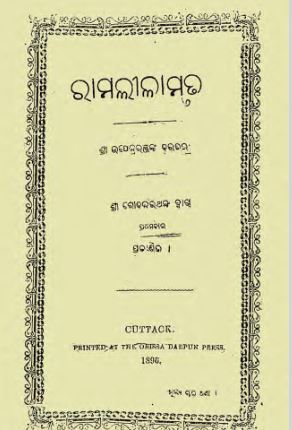Odia literature boasts a treasure trove of rich cultural and literary heritage, and within its vast repository stands the illustrious poet, Upendra Bhanja. His magnum opus, Ramalilamrut , published in 1896, serves as a testament to his poetic genius, narrative flair, and deep understanding of Odia ethos. This classic poem remains an indelible part of Odia literature and continues to inspire readers, scholars, and poets alike.
Ramalilamrut is a profound retelling of the timeless Ramayana, weaving together exquisite poetry, rich symbolism, and profound philosophical insights. The narrative, drawn from ancient Indian epics, delves into the life and adventures of Lord Rama, an incarnation of Vishnu, capturing his trials, tribulations, triumphs, and his undying principles of dharma (righteousness). What distinguishes Ramalilamrut is Bhanja’s unparalleled poetic style, which marries classical Odia metrical sophistication with the region’s vernacular expressions.
Hailed as the “Baida Byasa Kabi,” which translates to the poet equivalent to Vyasa, the author of Mahabharata, Upendra Bhanja’s contributions to Odia literature are monumental. Born into a royal family in the late 17th century, his literary pursuits earned him an enduring reputation that transcends centuries. His command over the intricacies of the Odia language, coupled with his innovative use of metaphor and simile, created a rich tapestry of verse that continues to resonate with audiences today.
Each verse of Ramalilamrut pulsates with Bhanja’s lyrical ingenuity. His language is lush and melodious, his descriptions vivid and enchanting. Be it the portrayal of the divine beauty of Sita, the gallant spirit of Lord Rama, the treacherous nature of Ravana, or the unfaltering loyalty of Hanuman, Bhanja’s depictions breathe life into characters that have transcended time and geography.
The poet’s adeptness at employing chitrakavya (poetic imagery) ensures that every stanza is not just read but experienced. His clever use of alliteration, onomatopoeia, and anagrams contributes to a musical quality that mirrors the traditional oral recitations of epics, thus preserving the cultural essence of storytelling.
Ramalilamrut is much more than a mere retelling of an epic. It embodies the essence of human values and ideals. Through Rama’s journey, Bhanja emphasizes virtues such as righteousness, loyalty, courage, and humility. The poem explores the human condition, addressing themes such as the triumph of good over evil, the importance of ethical conduct, and the search for justice and harmony.
The work also serves as a cultural bridge, linking the contemporary reader to the rich past of Odia literature and traditions. Its publication in 1896 marked a significant moment in literary history, reaffirming the cultural and spiritual tenets of the region at a time when India was on the cusp of modernity.
The legacy of Ramalilamrut persists in its ability to capture the imagination of readers across generations. Its lyrical beauty and philosophical depth ensure that it remains a cornerstone of Odia literature. The poem is not merely a relic of the past but continues to inspire contemporary poets, writers, and artists. In classrooms, literary circles, and performance spaces, Ramalilamrut is celebrated as a work of art that transcends the boundaries of time and space.
In commemorating Ramalilamrut, we celebrate Upendra Bhanja’s enduring legacy and the timeless beauty of Odia poetry. This classic is a testament to the profound depth and lyrical brilliance that Odia literature embodies, inviting readers to immerse themselves in a world where mythology, history, and poetry converge beautifully.
Books Info
| Books name | Ramalilamrut/ରାମଲୀଳାମୃତ |
| Author | Upendra Bhanja |
| No Of pages | 50 |
| Publisher | NA |
| Publication | 1896 |
| Printed At | NA |
| Distributor | NA |

